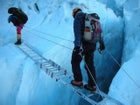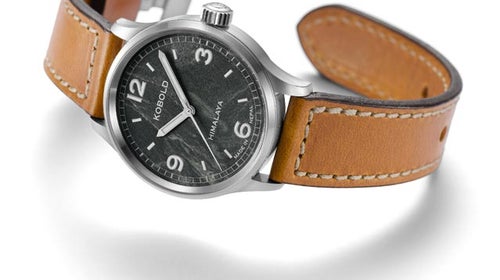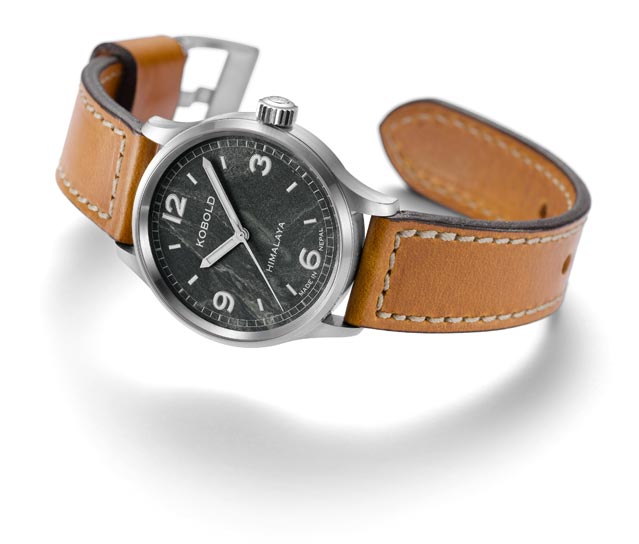Usually,┬árugged watches are built to┬áwithstand┬áextreme environments, like the bottom of the ocean or the top┬áthe world, not┬áwith┬áa few bits of nature found there. But the , the┬álatest timepiece from the celebrated Pennsylvania-based┬ábuilder of adventure-ready watches, isnÔÇÖt like most rugged watches.
 Crossing a crevasse in the Khumbu icefall
Crossing a crevasse in the Khumbu icefall Sir Ranulph Fiennes
Sir Ranulph FiennesUnveiled in late March,┬áthe $16,500 Himalaya Edition features an alligator-skin┬áband, three slender hands, andÔÇöcontentiouslyÔÇö a┬ágreenish-black┬ádial made from rocks removed near the┬ásummit of Mount Everest.┬áLocal papers, including NepalÔÇÖs largest, the┬áKantipur Daily, have been quick to point out that regulations┬áforbid the removal of natural objects from Mount Everest, a┬áUNESCO World┬áHeritage Site and part of . The Forestry Department has┬áreportedly sent Kobold a cease-and-desist letter.
News of┬áKoboldÔÇÖs splashy debut party earlier this spring only fanned the flames. Held┬áinside┬áa walled compound in downtown┬áKathmandu, the fete was attended by Nepalese┬ágenerals,┬ámembers of the deposed royal family, ambassadors from three countries,┬áand famed British explorer Sir Ranulph Twisleton-Wykeham-Fiennes. Of course,┬áthe resulting media coverage did┬álittle to dissuade potential buyers. The first┬ábatch of 10 Himalaya Editions sold out that night, and, as of this week, most┬áof the second batch, an additional 15 watches, were also spoken for.
Company┬áfounder Michael┬áKobold, a mountaineer and┬álover of Nepal, stresses that his intentions are nothing if not noble.┬áIn 2010, while climbing Everest himself, his oxygen┬áregulator┬ámalfunctioned, leaving him woozy and confused high on the mountain.┬áHis friends, longtime climbing Sherpas Ang Namgyal and Lhakpa Tundu, stepped in┬áto help. They tried to fix his┬áregulator, and when they couldnÔÇÖt, they doffed┬átheir own breathing equipment to give to him. ÔÇťThey saved my life,ÔÇŁ Kobold┬ásays.
In gratitude,┬áhe offered to train the duo in the family business, the comparatively safe┬áprofession of watchmaking. He put them up at his farm in Pennsylvania Amish┬ácountry, showed them┬ásome of America (ÔÇťWe really liked Malibu,ÔÇŁ says Namgyal),┬áand discovered that they were calm and detailed craftsmen. A year later, he┬ásecured them a workspace and a boutique shop front in┬áKathmandu. According to┬áKobold, the Himalaya Edition was meant to attract positive attention to a whole┬áline of ÔÇťMade in NepalÔÇŁ wristwatches, eight styles that will be rolling out in┬ácoming┬ámonths.
ÔÇťTaking rocks┬áis not a big deal,ÔÇŁ Kobold says. ÔÇťLiterally everyone does it and has done it┬ásince Everest was first climbed.ÔÇŁ
Will the┬ákerfuffle pass, or will the Forestry Department make an example of Kobold? Time┬áwill tell.┬áMeanwhile,┬áthose intent on buying a bit of the big hill should also consider KroneÔÇÖs┬áSir┬áEdmund┬áHillary Mount Everest commemorative fountain pen, with a bit of Everest┬ásummit rock embedded in the cap. The writing utensil, the only other┬áÔÇťcollectibleÔÇŁ┬ásummit paraphernalia weÔÇÖve run┬áacross,┬áregularly appears on eBay for around $1,400ÔÇöabout the same as┬áwhat new ones sold for new in Beverly Hills in the late ÔÇś90s. ┬á


